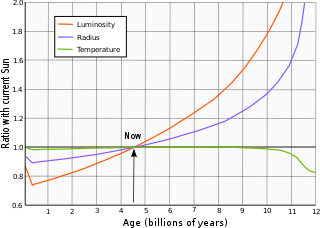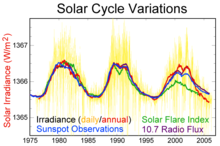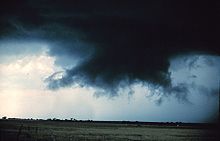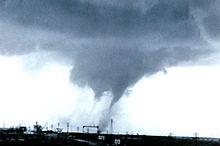The Sun is a G-type main sequence star comprising about 99.8632% of the total mass of the Solar System. It is a near-perfect sphere, with an oblateness estimated at about 9 millionths, which means that its polar diameter differs from its equatorial diameter by only 10 km. As the Sun consists of a plasma and is not solid, it rotates faster at its equator than at its poles. This behavior is known as differential rotation, and is caused by convection in the Sun and the movement of mass, due to steep temperature gradients from the core outwards. This mass carries a portion of the Sun’s counter-clockwise angular momentum, as viewed from the ecliptic north pole, thus redistributing the angular velocity. The period of this actual rotation is approximately 25.6 days at the equator and 33.5 days at the poles. However, due to our constantly changing vantage point from the Earth as it orbits the Sun, the apparent rotation of the star at its equator is about 28 days. The centrifugal effect of this slow rotation is 18 million times weaker than the surface gravity at the Sun's equator. The tidal effect of the planets is even weaker, and does not significantly affect the shape of the Sun.
The Sun is a Population I, or heavy element-rich, star. The formation of the Sun may have been triggered by shockwaves from one or more nearby supernovae. This is suggested by a high abundance of heavy elements in the Solar System, such as gold and uranium, relative to the abundances of these elements in so-called Population II (heavy element-poor) stars. These elements could most plausibly have been produced by endergonic nuclear reactions during a supernova, or by transmutation through neutron absorption inside a massive second-generation star.

The Sun shows a C3-class solar flare (white area on upper left), a solar tsunami (wave-like structure, upper right) and multiple filaments of magnetism lifting off the stellar surface.
The Sun does not have a definite boundary as rocky planets do, and in its outer parts the density of its gases drops exponentially with increasing distance from its center. Nevertheless, it has a well-defined interior structure, described below. The Sun's radius is measured from its center to the edge of the photosphere. This is simply the layer above which the gases are too cool or too thin to radiate a significant amount of light, and is therefore the surface most readily visible to the naked eye.

An illustration of the structure of the Sun:
1. Core
2. Radiative zone
3. Convective zone
4. Photosphere
5. Chromosphere
6. Corona
7. Sunspot
8. Granules
9. Prominence
The solar interior is not directly observable, and the Sun itself is opaque to electromagnetic radiation. However, just as seismology uses waves generated by earthquakes to reveal the interior structure of the Earth, the discipline of helioseismology makes use of pressure waves (infrasound) traversing the Sun's interior to measure and visualize the star's inner structure. Computer modeling of the Sun is also used as a theoretical tool to investigate its deeper layers.
Core

Cross-section of a solar-type star (NASA)
The core of the Sun is considered to extend from the center to about 20–25% of the solar radius. It has a density of up to 150 g/cm3 (about 150 times the density of water) and a temperature of close to 13.6 million kelvin (K). By contrast, the Sun's surface temperature is approximately 5,800 K. Recent analysis of SOHO mission data favors a faster rotation rate in the core than in the rest of the radiative zone. Through most of the Sun's life, energy is produced by nuclear fusion through a series of steps called the p–p (proton–proton) chain; this process converts hydrogen into helium. Less than 2% of the helium generated in the Sun comes from the CNO cycle.
The core is the only region in the Sun that produces an appreciable amount of thermal energy through fusion; inside 24% of the Sun's radius, 99% of the power has been generated, and by 30% of the radius, fusion has stopped nearly entirely. The rest of the star is heated by energy that is transferred outward from the core and the layers just outside. The energy produced by fusion in the core must then travel through many successive layers to the solar photosphere before it escapes into space as sunlight or kinetic energy of particles.
The proton–proton chain occurs around 9.2×1037 times each second in the core of the Sun. Since this reaction uses four free protons (hydrogen nuclei), it converts about 3.7×1038 protons to alpha particles (helium nuclei) every second (out of a total of ~8.9×1056 free protons in the Sun), or about 6.2×1011 kg per second. Since fusing hydrogen into helium releases around 0.7% of the fused mass as energy, the Sun releases energy at the mass-energy conversion rate of 4.26 million metric tons per second, 384.6 yotta watts (3.846×1026 W), or 9.192×1010 megatons of TNT per second. This mass is not destroyed to create the energy, rather, the mass is carried away in the radiated energy, as described by the concept of mass-energy equivalence.
The power production by fusion in the core varies with distance from the solar center. At the center of the Sun, theoretical models estimate it to be approximately 276.5 watts/m3, a power production density that more nearly approximates reptile metabolism than a thermonuclear bomb.[note 2] Peak power production in the Sun has been compared to the volumetric heats generated in an active compost heap. The tremendous power output of the Sun is not due to its high power per volume, but instead due to its large size.
The fusion rate in the core is in a self-correcting equilibrium: a slightly higher rate of fusion would cause the core to heat up more and expand slightly against the weight of the outer layers, reducing the fusion rate and correcting the perturbation; and a slightly lower rate would cause the core to cool and shrink slightly, increasing the fusion rate and again reverting it to its present level.
The gamma rays (high-energy photons) released in fusion reactions are absorbed in only a few millimeters of solar plasma and then re-emitted again in random direction and at slightly lower energy. Therefore it takes a long time for radiation to reach the Sun's surface. Estimates of the photon travel time range between 10,000 and 170,000 years. Since energy transport in the Sun is a process which involves photons in thermodynamic equilibrium with matter, the time scale of energy transport in the Sun is longer, on the order of 30,000,000 years. This is the time it would take the Sun to return to a stable state if the rate of energy generation in its core were suddenly to be changed.
After a final trip through the convective outer layer to the transparent surface of the photosphere, the photons escape as visible light. Each gamma ray in the Sun's core is converted into several million photons of visible light before escaping into space. Neutrinos are also released by the fusion reactions in the core, but unlike photons they rarely interact with matter, so almost all are able to escape the Sun immediately. For many years measurements of the number of neutrinos produced in the Sun were lower than theories predicted by a factor of 3. This discrepancy was resolved in 2001 through the discovery of the effects of neutrino oscillation: the Sun emits the number of neutrinos predicted by the theory, but neutrino detectors were missing 2⁄3 of them because the neutrinos had changed flavor by the time they were detected.
Radiative zone
From about 0.25 to about 0.7 solar radii, solar material is hot and dense enough that thermal radiation is sufficient to transfer the intense heat of the core outward. This zone is free of thermal convection; while the material gets cooler from 7 to about 2 million kelvin with increasing altitude, this temperature gradient is less than the value of the adiabatic lapse rate and hence cannot drive convection. Energy is transferred by radiation—ions of hydrogen and helium emit photons, which travel only a brief distance before being reabsorbed by other ions. The density drops a hundredfold (from 20 g/cm3 to only 0.2 g/cm3) from the bottom to the top of the radiative zone.
The radiative zone and the convection form a transition layer, the tachocline. This is a region where the sharp regime change between the uniform rotation of the radiative zone and the differential rotation of the convection zone results in a large shear—a condition where successive horizontal layers slide past one another. The fluid motions found in the convection zone above, slowly disappear from the top of this layer to its bottom, matching the calm characteristics of the radiative zone on the bottom. Presently, it is hypothesized (see Solar dynamo), that a magnetic dynamo within this layer generates the Sun's magnetic field.
Convective zone
In the Sun's outer layer, from its surface down to approximately 200,000 km (or 70% of the solar radius), the solar plasma is not dense enough or hot enough to transfer the thermal energy of the interior outward through radiation; in other words it is opaque enough. As a result, thermal convection occurs as thermal columns carry hot material to the surface (photosphere) of the Sun. Once the material cools off at the surface, it plunges downward to the base of the convection zone, to receive more heat from the top of the radiative zone. At the visible surface of the Sun, the temperature has dropped to 5,700 K and the density to only 0.2 g/m3 (about 1/6,000th the density of air at sea level).
The thermal columns in the convection zone form an imprint on the surface of the Sun as the solar granulation and supergranulation. The turbulent convection of this outer part of the solar interior causes a "small-scale" dynamo that produces magnetic north and south poles all over the surface of the Sun. The Sun's thermal columns are Bénard cells and therefore tend to be hexagonal prisms.
Photosphere
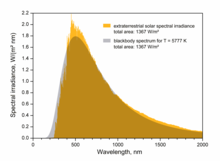
The effective temperature, or black body temperature, of the Sun (5777 K) is the temperature a black body of the same size must have to yield the same total emissive power.
The visible surface of the Sun, the photosphere, is the layer below which the Sun becomes opaque to visible light. Above the photosphere visible sunlight is free to propagate into space, and its energy escapes the Sun entirely. The change in opacity is due to the decreasing amount of H− ions, which absorb visible light easily. Conversely, the visible light we see is produced as electrons react with hydrogen atoms to produce H− ions. The photosphere is tens to hundreds of kilometers thick, being slightly less opaque than air on Earth. Because the upper part of the photosphere is cooler than the lower part, an image of the Sun appears brighter in the center than on the edge or limb of the solar disk, in a phenomenon known as limb darkening. Sunlight has approximately a black-body spectrum that indicates its temperature is about 6,000 K, interspersed with atomic absorption lines from the tenuous layers above the photosphere. The photosphere has a particle density of ~1023 m−3 (this is about 0.37% of the particle number per volume of Earth's atmosphere at sea level; however, photosphere particles are electrons and protons, so the average particle in air is 58 times as heavy).
During early studies of the optical spectrum of the photosphere, some absorption lines were found that did not correspond to any chemical elements then known on Earth. In 1868, Norman Lockyer hypothesized that these absorption lines were because of a new element which he dubbed helium, after the Greek Sun god Helios. It was not until 25 years later that helium was isolated on Earth.
Atmosphere

During a total solar eclipse, the solar corona can be seen with the naked eye, during the brief period of totality.
The parts of the Sun above the photosphere are referred to collectively as the solar atmosphere. They can be viewed with telescopes operating across the electromagnetic spectrum, from radio through visible light to gamma rays, and comprise five principal zones: the temperature minimum, the chromosphere, the transition region, the corona, and the heliosphere. The heliosphere, which may be considered the tenuous outer atmosphere of the Sun, extends outward past the orbit of Pluto to the heliopause, where it forms a sharp shock front boundary with the interstellar medium. The chromosphere, transition region, and corona are much hotter than the surface of the Sun. The reason has not been conclusively proven; evidence suggests that Alfvén waves may have enough energy to heat the corona.
The coolest layer of the Sun is a temperature minimum region about 500 km above the photosphere, with a temperature of about 4,100 K. This part of the Sun is cool enough to support simple molecules such as carbon monoxide and water, which can be detected by their absorption spectra.
Above the temperature minimum layer is a layer about 2,000 km thick, dominated by a spectrum of emission and absorption lines. It is called the chromosphere from the Greek root chroma, meaning color, because the chromosphere is visible as a colored flash at the beginning and end of total eclipses of the Sun. The temperature in the chromosphere increases gradually with altitude, ranging up to around 20,000 K near the top. In the upper part of chromosphere helium becomes partially ionized.

Taken by Hinode's Solar Optical Telescope on January 12, 2007, this image of the Sun reveals the filamentary nature of the plasma connecting regions of different magnetic polarity.
Above the chromosphere, in a thin (about 200 km) transition region, the temperature rises rapidly from around 20,000 K in the upper chromosphere to coronal temperatures closer to 1,000,000 K. The temperature increase is facilitated by the full ionization of helium in the transition region, which significantly reduces radiative cooling of the plasma. The transition region does not occur at a well-defined altitude. Rather, it forms a kind of nimbus around chromospheric features such as spicules and filaments, and is in constant, chaotic motion. The transition region is not easily visible from Earth's surface, but is readily observable from space by instruments sensitive to the extreme ultraviolet portion of the spectrum.
The corona is the extended outer atmosphere of the Sun, which is much larger in volume than the Sun itself. The corona continuously expands into space forming the solar wind, which fills all the Solar System. The low corona, near the surface of the Sun, has a particle density around 1015–1016 m−3. The average temperature of the corona and solar wind is about 1,000,000–2,000,000 K; however, in the hottest regions it is 8,000,000–20,000,000 K. While no complete theory yet exists to account for the temperature of the corona, at least some of its heat is known to be from magnetic reconnection.
The heliosphere, which is the cavity around the Sun filled with the solar wind plasma, extends from approximately 20 solar radii (0.1 AU) to the outer fringes of the Solar System. Its inner boundary is defined as the layer in which the flow of the solar wind becomes superalfvénic—that is, where the flow becomes faster than the speed of Alfvén waves. Turbulence and dynamic forces outside this boundary cannot affect the shape of the solar corona within, because the information can only travel at the speed of Alfvén waves. The solar wind travels outward continuously through the heliosphere, forming the solar magnetic field into a spiral shape, until it impacts the heliopause more than 50 AU from the Sun. In December 2004, the Voyager 1 probe passed through a shock front that is thought to be part of the heliopause. Both of the Voyager probes have recorded higher levels of energetic particles as they approach the boundary.
Magnetic field
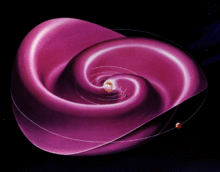
The heliospheric current sheetplasma in the interplanetary medium. extends to the outer reaches of the Solar System, and results from the influence of the Sun's rotating magnetic field on the
The Sun is a magnetically active star. It supports a strong, changing magnetic field that varies year-to-year and reverses direction about every eleven years around solar maximum. The Sun's magnetic field leads to many effects that are collectively called solar activity, including sunspots on the surface of the Sun, solar flares, and variations in solar wind that carry material through the Solar System. Effects of solar activity on Earth include auroras at moderate to high latitudes, and the disruption of radio communications and electric power. Solar activity is thought to have played a large role in the formation and evolution of the Solar System. Solar activity changes the structure of Earth's outer atmosphere.
All matter in the Sun is in the form of gas and plasma because of its high temperatures. This makes it possible for the Sun to rotate faster at its equator (about 25 days) than it does at higher latitudes (about 35 days near its poles). The differential rotation of the Sun's latitudes causes its magnetic field lines to become twisted together over time, causing magnetic field loops to erupt from the Sun's surface and trigger the formation of the Sun's dramatic sunspots and solar prominences (see magnetic reconnection). This twisting action creates the solar dynamo and an 11-year solar cycle of magnetic activity as the Sun's magnetic field reverses itself about every 11 years.
The solar magnetic field extends well beyond the Sun itself. The magnetized solar wind plasma carries Sun's magnetic field into the space forming what is called the interplanetary magnetic field.
Since the plasma can only move along the magnetic field lines, the interplanetary magnetic field is initially stretched radially away from the Sun. Because the fields above and below the solar equator have different polarities pointing towards and away from the Sun, there exists a thin current layer in the solar equatorial plane, which is called the heliospheric current sheet.
At the large distances the rotation of the Sun twists the magnetic field and the current sheet into the Archimedean spiral like structure called the Parker spiral.
The interplanetary magnetic field is much stronger than the dipole component of the solar magnetic field. The Sun's 50–400 μT (in the photosphere) magnetic dipole field reduces with the cube of the distance to about 0.1 nT at the distance of the Earth. However, according to spacecraft observations the interplanetary field at the Earth's location is about 100 times greater at around 5 nT.

